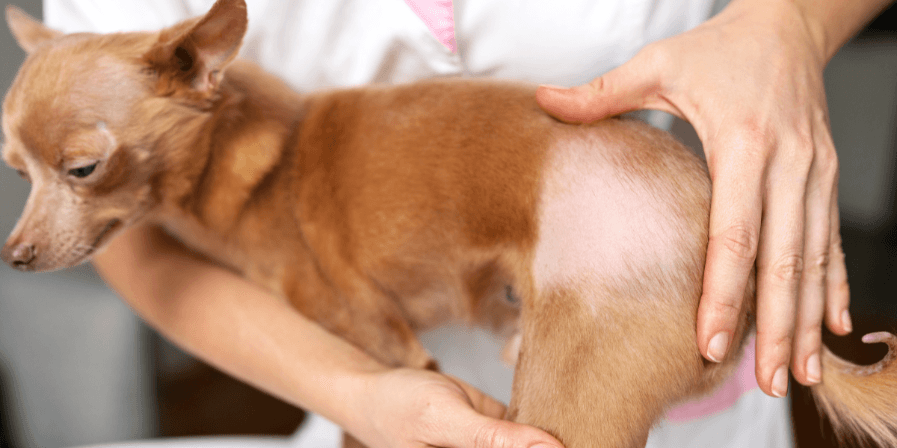Alopecia X in Dogs

Alopecia X, commonly referred to as black skin disease, is a puzzling and often frustrating condition affecting the coat of certain dog breeds, particularly those with thick double coats. Characterized by progressive hair loss and skin darkening, this disorder does not cause pain or discomfort, but it can be a source of concern for pet owners who notice their dog’s once-lush fur gradually thinning. While Alopecia X is primarily a cosmetic condition, many owners seek treatment to restore their pet’s coat and ensure their overall well-being.
This blog explores Alopecia X in detail, covering its causes, symptoms, diagnosis, and available treatment options, so pet owners can make informed decisions about managing this condition.
What is Alopecia X?
Alopecia X is a non-inflammatory skin disorder that causes symmetrical hair loss, primarily affecting breeds with plush, dense fur. Despite years of research, the exact cause remains unknown, which is why the condition is referred to as Alopecia "X"—indicating an unidentified factor. The condition is most commonly seen in breeds such as Pomeranians, Alaskan Malamutes, Chow Chows, Siberian Huskies, Samoyeds, and Miniature Poodles. It tends to appear in young adult dogs between the ages of one and three, although cases have been reported in older dogs as well. Males seem to be more frequently affected than females. Although Alopecia X leads to significant coat changes, it does not impact a dog’s overall health. Affected dogs remain active and behave normally, with no signs of itching, pain, or infections. However, since hair loss can sometimes indicate underlying medical conditions, it’s important to have a veterinarian examine any dog experiencing unexplained fur thinning.
Causes and Risk Factors
The exact cause of Alopecia X remains unknown, but several theories suggest possible contributing factors. One leading hypothesis is that the condition results from a hormonal imbalance, particularly involving adrenal sex hormones, melatonin, or growth hormones. In some cases, spaying or neutering has led to hair regrowth, further supporting the idea that reproductive hormones may play a role. Genetics is also believed to be a significant factor, as the condition occurs more frequently in certain breeds. Additionally, researchers have examined melatonin deficiencies as a possible cause, given melatonin’s role in regulating hair growth cycles. Despite these theories, there is no single identified cause, making it difficult to predict which dogs will develop Alopecia X.
Symptoms of Alopecia X
The most noticeable sign of Alopecia X is gradual, symmetrical hair loss, typically beginning at the back of the thighs and tail. As the condition progresses, the bald patches spread to the neck, trunk, and perineal area (around the anus), while the head and front legs usually remain unaffected. In addition to hair loss, affected dogs often develop hyperpigmentation, which gives the exposed skin a darkened, blackish appearance. The texture of the skin may also change, becoming smooth and thin over time. Despite these changes, dogs with Alopecia X do not experience itching, redness, or discomfort, distinguishing the condition from inflammatory skin disorders. Hair loss tends to progress slowly, and while some dogs experience partial regrowth over time, others remain hairless for the rest of their lives. Since Alopecia X does not affect a dog's overall health, many pet owners choose to embrace their dog’s unique look rather than pursue treatment.
Diagnosing Alopecia X
Since hair loss can be a symptom of various medical conditions, diagnosing Alopecia X requires ruling out other potential causes. Hypothyroidism and Cushing’s disease are two common endocrine disorders that cause hair loss and require medical treatment, so veterinarians must first confirm that these conditions are not responsible for the symptoms.
A veterinarian will typically conduct:
• A physical examination to assess the pattern and distribution of hair loss.
• Skin scrapings and fungal tests to rule out infections, parasites, or ringworm.
• Blood tests and hormone panels to check for endocrine disorders.
• Skin biopsies in some cases to examine hair follicles and rule out other skin diseases.
If test results come back normal and no other underlying conditions are found, the diagnosis of Alopecia X is likely. Some veterinarians may attempt a trial treatment (such as melatonin supplementation) to see if hair regrowth occurs, further supporting the diagnosis.
Treatment Options
Although Alopecia X is a cosmetic condition, some pet owners seek treatment to encourage hair regrowth. Since there is no single proven cure, different treatments may work for different dogs, and some cases may not respond to treatment at all. One of the first recommended approaches is spaying or neutering the affected dog. In some cases, this leads to hair regrowth within several months, suggesting a hormonal link. However, this does not guarantee a successful outcome for all dogs. Melatonin supplementation is another common treatment. Melatonin is a naturally occurring hormone that plays a role in hair growth cycles. Many veterinarians recommend melatonin therapy because it is safe, affordable, and well-tolerated. Results may take several months, and while some dogs experience full or partial hair regrowth, others may not respond. In more persistent cases, veterinarians may prescribe adrenal-targeting medications, such as trilostane or mitotane, which regulate hormone production. These medications are typically reserved for severe cases, as they carry potential side effects.
Supportive care can also help maintain skin health in dogs with Alopecia X. Regular moisturizing shampoos and omega-3 fatty acid supplements can keep the skin hydrated and improve overall coat quality. Since bald areas are more vulnerable to sunburn and temperature changes, owners should provide adequate protection, such as dog-friendly sunscreen or lightweight clothing in extreme weather.
Prognosis and Long-Term Care
The prognosis for dogs with Alopecia X is generally positive, as the condition does not impact overall health or lifespan. However, hair regrowth is unpredictable, and not all treatments are effective. Some dogs regain their coats partially or fully, while others remain hairless despite various treatments. For pet owners who choose not to pursue treatment, monitoring the condition is important to ensure that the dog’s skin remains healthy. Since hairless skin can be prone to dryness, flaking, or secondary infections, regular check-ups with a veterinarian are recommended. While Alopecia X may cause frustration due to its persistent nature, many owners find that their dogs continue to live happy, active lives with or without a full coat. With proper care and management, affected dogs can thrive just as well as their fully-furred counterparts.
Final Thoughts
Alopecia X is a unique and often mysterious condition that primarily affects Nordic breeds with thick fur. While the exact cause remains unknown, the condition is believed to be linked to hormonal imbalances or genetic factors. Hair loss is progressive and permanent in some cases, but since Alopecia X does not cause discomfort, it does not require treatment unless desired for cosmetic reasons. If your dog is experiencing unexplained hair loss, consulting a veterinarian is essential to rule out other potential causes. With the right approach, owners can ensure their pet remains comfortable and healthy, whether they choose to pursue treatment or simply embrace their dog’s unique look.
FAQs
1. Can Alopecia X be prevented in dogs?
Currently, there is no known way to prevent Alopecia X, as its exact cause remains unidentified. However, maintaining good skin and coat health through a nutritionally balanced diet, regular grooming, and omega-3 fatty acid supplements may help support healthy hair growth. Since the condition has a genetic component, responsible breeding practices may reduce the likelihood of passing it on.
2. Will my dog's hair grow back if they have Alopecia X?
Hair regrowth in dogs with Alopecia X is unpredictable. Some dogs experience partial or full regrowth after spaying/neutering, melatonin supplementation, or other treatments, while others remain hairless permanently. Since the condition does not cause pain or health issues, many owners choose to manage skin care rather than focus on regrowth.


 How can we help?
How can we help?